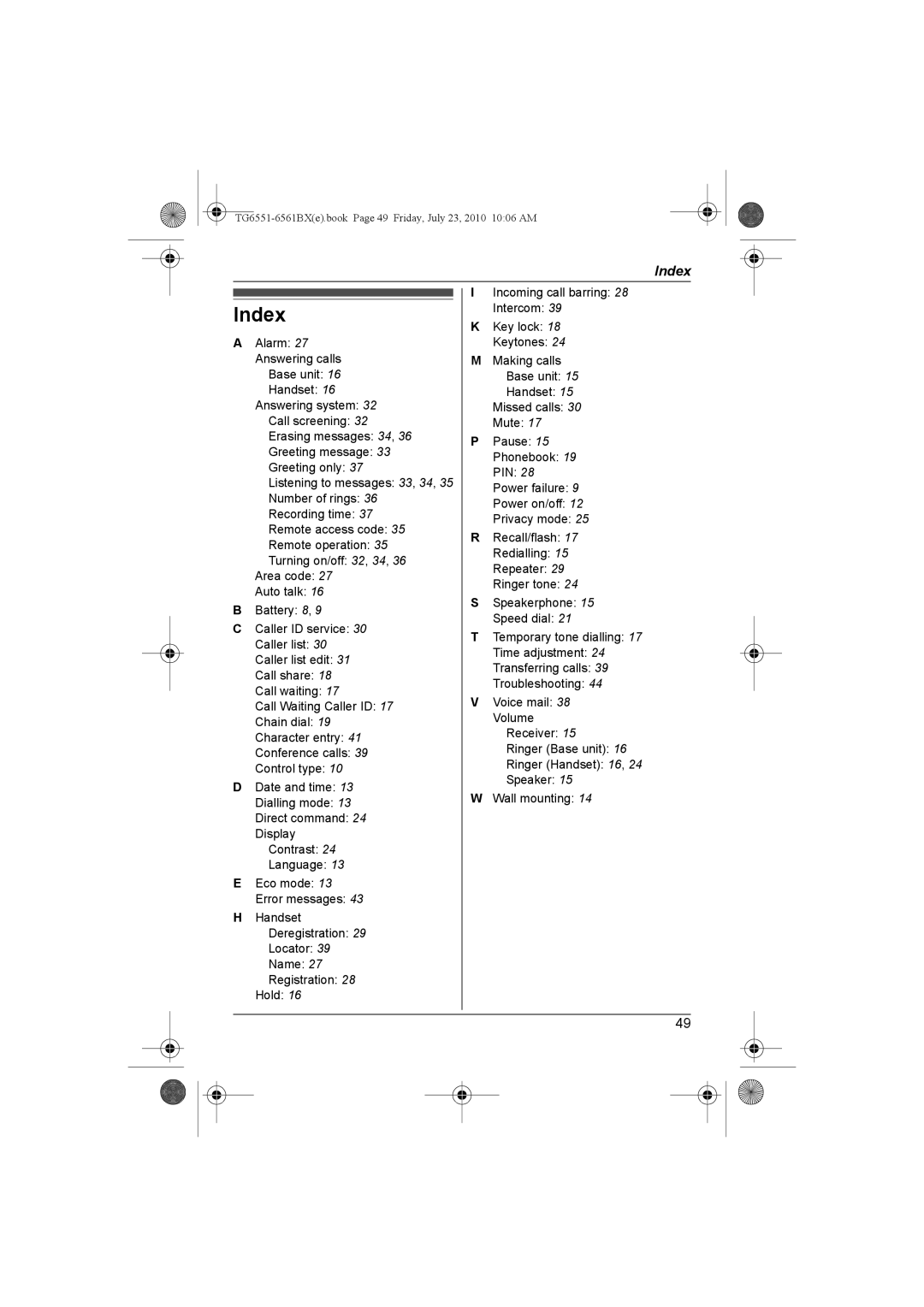Before initial use, see Getting Started on
Voice Mail Service
Caller ID Service
Introduction
Important Information
Supplied accessories
Accessory information
Accessory item/Part number Quantity
Model composition
Accessory item Model number
Additional/replacement accessories
For your safety
Important safety instructions
Other information
Battery installation
Setting up
Battery charge
Connections
Battery level Icon
During a power failure
Operation Operating time
Handset
Controls
Base unit
Display
Charge contacts Speaker Stop Erase Play Message indicator
Handset display items Meaning
Power on
Turning the power on/off
Power off
Soft key icons Icon Action
One touch eco mode
Initial settings
Dialling mode
Display language
Wall mounting
Pause for PBX/long distance service users
Using the base unit
Using the handset
Useful features during a call
Answering calls
Hold
Mute
Temporary tone dialling for rotary/pulse service users
Recall/flash
Call share
Handset key lock
Handset phonebook
TG6551-6561BXe.book Page 20 Friday, July 23, 2010 1006 AM
Base unit speed dial
Making a call using the speed
Dial keys
Adding phone numbers to
Programming by scrolling through the display menus
Programmable settings
Main menu Sub-menu
Ringer Setup*1 Ringer Volume Ringtone
Feature Code Setting
Programming using the direct commands
For the answering system KX-TG6561 Feature Code Setting
TG6551-6561BXe.book Page 26 Friday, July 23, 2010 1006 AM
Special programming
Alarm
Changing the handset name
Storing an area code to be deleted automatically
Incoming call barring Caller ID subscribers only
Registering a unit
Changing the base unit PIN Personal Identification Number
Registering a handset to the base unit
Increasing the range of the base unit
Setting the repeater mode
Deregistering a handset
Caller ID features
Using Caller ID service
Caller list
Viewing the caller list and calling back
Erasing selected caller information
Editing a caller’s phone number before calling back
Erasing all caller information
Storing caller information to the phonebook
Turning the answering system on/off
Answering system
Memory capacity including your greeting message
Call screening
Using a pre-recorded greeting message
Listening to messages using the base unit
Greeting message
Recording your greeting message
Operating the answering system during playback
Listening to messages using the handset
Erasing all messages
Operating the answering system
Using the answering system remotely
Remote access code
Remote operation
Calling back Caller ID subscribers only
Remote commands
Answering system settings
Turning on the answering system remotely
Number of rings before the unit answers a call
Selecting Greeting Only
Caller’s recording time
Voice mail service
Handset locator
Intercom
Transferring calls, conference calls
Making an intercom call
To establish a conference call Press
To complete the transfer Press s
Answering a transferred call Handset
Character entry modes
Character entry
Persian character table
Numeric entry table Arabic character table
Extended character table N
Display message Cause/solution
Error messages
General use Problem Cause/solution
Troubleshooting
Problem Cause/solution
Making/answering calls, intercom
Battery recharge Problem Cause/solution
Caller ID Problem Cause/solution
Own greeting message again
Answering system KX-TG6561
Liquid damage Problem Cause/solution
Index
TG6551-6561BXe.book Page 50 Friday, July 23, 2010 1006 AM
TG6551-6561BXe.book Page 51 Friday, July 23, 2010 1006 AM
Copyright
For your future reference

